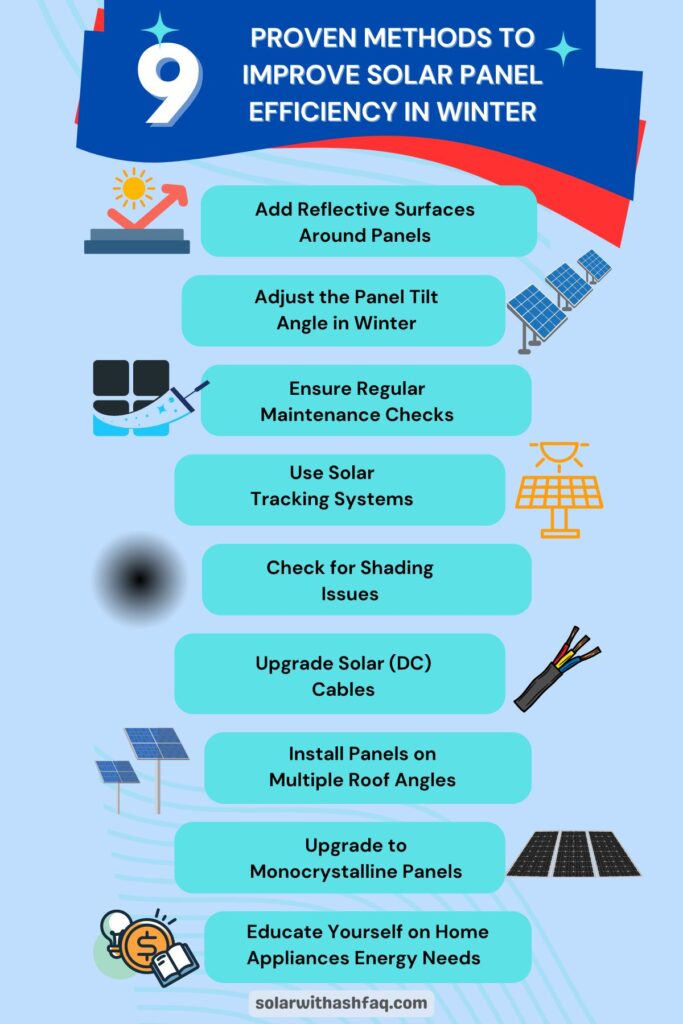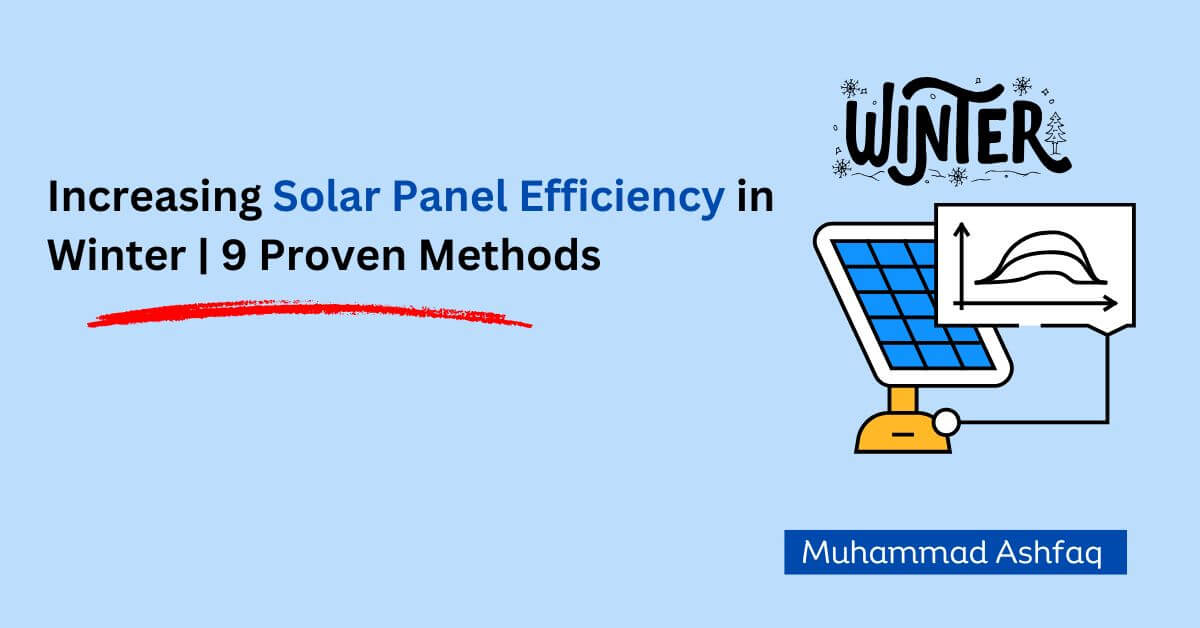9 Proven Methods to Improve Solar Panel Efficiency in Winter
Winter is here, and if you’re like me, you’re probably looking for ways to keep your solar panels running at their best during the cold months.
Even with shorter days and less sunlight, there are smart and simple strategies to boost your system’s efficiency and make the most of every ray of sunshine.
From adjusting panel angles to upgrading cables and using reflective surfaces, these energy-saving tips will help you squeeze every bit of power from your solar setup.
In this guide, I’ll be going into 9 proven methods to improve solar panel efficiency in winter.
With a little effort and the right tweaks, you can keep your solar power working at optimal performance!

Add Reflective Surfaces Around Panels
Placing reflective surfaces, like white ground covers, beneath solar panels can boost energy output.
Research from the University of Ottawa found that artificial reflectors can increase solar energy production by as much as 4.5%.
Simple materials like shiny white plastic sheets or boards work well. They’re light, easy to manage, and reflect sunlight back to the panels.
Bifacial panels benefit even more since they absorb light from both sides.
A straightforward option?
Just use standard white paint on the surfaces around your panels.
Adjust the Panel Tilt Angle in Winter
To find the best angle for your solar panels in winter, add 15 degrees to the latitude where you live. Latitude is how far you are from the equator.
For example, if your latitude is 40°, your panel angle should be about 55° in the winter.
You can find your latitude angle using this online tool.
If your solar panels can be adjusted by hand, try changing the angle at the beginning of winter and then again in spring.
If your panels can’t be moved, set them at the winter angle based on your latitude. This will help you get the most energy during the cold months.
And regularly watch how much energy your panels make after you adjust them. This way, you can find the best angle for your location.
Ensure Regular Maintenance Checks
Remember, the easier the maintenance, the more effective it will be. To get optimal performance in winter, below are the simple checks:
Keep Panels Clear: Snow and ice block sunlight and can lower energy output. Avoid using metal tools that might scratch the panels.
Watch for Dust: Dust can gather on the panels and reduce efficiency. Clean panels regularly to keep them working well.
Check Your Panels: Look for cracks, scratches, or other damage. Make sure all connections are tight and in good condition.
By taking these simple steps, you’ll help your solar panels last longer and work better.
Also, taking these proactive steps will help extend the lifespan of your solar investment.
Use Solar Tracking Systems
Solar trackers help increase energy output, especially in the morning and evening. They adjust the panel angles to capture more sunlight, even on cloudy days.
Here’s a quick look at how they work:
Single-Axis Trackers
These trackers move in one direction, usually north to south. They let panels follow the sun from east to west. This boosts energy production by 25% to 35%, which is helpful in winter when the sun is lower.
Dual-Axis Trackers
These trackers move both up and down, and side to side. This helps them follow the sun more accurately all year. They can increase energy by up to 40%, making them great for shorter winter days when sunlight is limited.
Check for Shading Issues
Shading can come from trees, buildings, or even snow. It affects how much sunlight your solar panels get.
Soft Shading: This happens when things like tree branches or clouds block some of the sunlight. It doesn’t fully block the sun but can still lower energy output.
Hard Shading: Dust, bird droppings, or other objects can block sunlight completely. Even a small amount of hard shading on one cell can lower the energy output of the whole panel.
Here are some tips to handle shading:
- Check for shading before installing your panels.
- Use bypass diodes to help panels keep working if a part is shaded.
- Install microinverters or DC optimizers so each panel works on its own.
- Group shaded panels separately so unshaded ones still work well.
- Trim trees and plants that might block the sunlight.
Upgrade Solar (DC) Cables
Use good quality cables with the right size to cut down resistance. This helps stop voltage drop.
It’s super important in winter when panels make less energy due to short days and low sunlight.
Less voltage drop means more power reaches your home.
Plus, upgraded cables also handle higher currents without getting too hot, which lowers fire risks.
For most home systems, use 10 AWG or 8 AWG cables if your wires are longer than 25 feet. It depends on the size of your system.
Install Panels on Multiple Roof Angles
Panels facing different directions—like south, east, and west—can capture sunlight at various times of the day.
That means you will get steady energy output, even in winter when the days are shorter.
How it’s a smart way to capture your solar power?
By placing panels on different parts of your roof, you make sure some panels are always catching sunlight, even if others get shaded.
However, setting up panels at multiple angles can be tricky. It makes the installation process a bit more complex and costly because of the extra design work and hardware needed.
But the payoff in reliable energy is worth it!
Upgrade to Monocrystalline Panels
Monocrystalline panels are known for their high efficiency, ranging from 20% to 22%. This increased efficiency is more noticeable in winter.
As temperatures drop, the silicon in these panels conducts electricity better, enabling them to produce more power than in hot weather.
Because they are efficient, monocrystalline panels need less space to generate the same amount of energy compared to other types, like polycrystalline panels.
This makes them great for homes with limited roof space.
But keep in mind, that these panels are more expensive. You pay more initially, but their high efficiency and better performance in cold weather can make them a great long-term investment!
Educate Yourself on Home Appliances Energy Needs
Knowing how much energy your appliances use helps you make smart choices about managing your solar power.
Result? Efficient use of your available energy.
Here’s how to take control:
Check Energy ratings
Look at the energy labels on your appliances to see their wattage and yearly energy use. This helps you spot which appliances are using most of your solar power.
Consider Upgrading “White Elephants”
Find the appliances that consume the most energy—often called “white elephants”—and consider upgrading them. Newer, energy-efficient models save a lot of power.
Shift Usage to Daylight Hours
Use high-energy appliances like water pumps and washing machines during peak sunlight hours. Running them during the day makes the most of your solar energy.
Smart Plugs and Timers
Smart plugs and timers can help you run appliances when your solar panels are producing the most energy. This simple step rationalizes your solar power usage.
Invest in Battery Systems
Adding a solar battery lets you store extra energy produced on sunny days for use at night or on cloudy days. Make sure your battery is well-insulated to work efficiently in cold weather.
Final Words
Wrapping up: Winter doesn’t have to mean a drop in your solar energy production.
Every small change adds up, helping you save energy, reduce costs, and make the most of your solar investment.
So, take charge of your solar system this winter! With these tips, you’ll be ready to enjoy reliable, clean energy all year round, no matter how the weather is!
FAQs
Yes, solar panels work in cold temperatures as the silicon conducts electricity more efficiently, though shorter days can reduce overall output.
Yes, solar trackers can boost energy output by adjusting panel angles to follow the sun, increasing efficiency by up to 30% even during shorter winter days.
Solar panels are designed to withstand cold temperatures, but extreme cold, heavy snow, or ice buildup can sometimes cause micro-cracks.
Solar energy production is generally higher in summer due to longer daylight hours and more direct sunlight. However, solar panels can still perform well in winter.
Absolutely. Snow blocks sunlight, so gently removing it with a soft brush or rake helps maintain energy production.

Content Writer | Assistant Manager (Electrical) at IESCO
As a passionate content writer, I’m on a mission to make solar hassle-free for you through my expert guides and easy-to-digest content.

